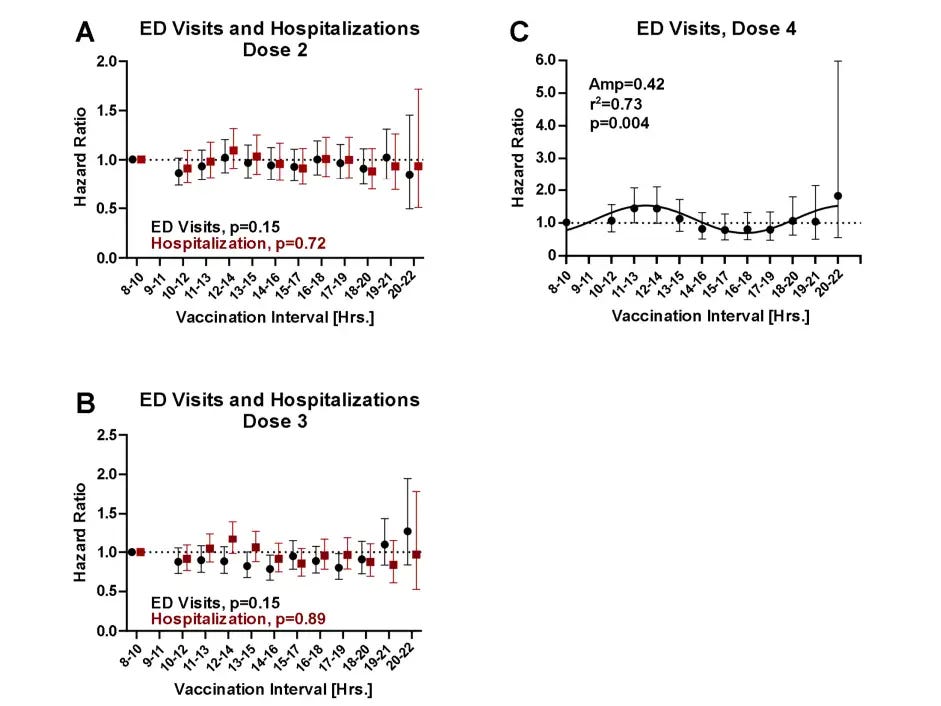Nature headline: “Timing matters for COVID vaccine effectiveness: Younger and older people gained greater protection if they had their jabs in the middle of the day.” Good joke: “Went from ‘95% effective’ to ‘only works if you get it at lunch time’”.
The peer-reviewed paper is “Biological rhythms in COVID-19 vaccine effectiveness in an observational cohort study of 1.5 million patients” by Guy Hazan and some unknown number of others (the list of names has an ellipsis!) in the Journal of Clinical Investigation.
I can’t beat the opening joke. But I might be able to explain how our authors came to provide the material for it. A dismal, thankless task, because once you pull out the humor-scope, you paralyze all possibility of laughter. Please forgive me.
Obvious thing first: it is absurd. The result. It is ridiculous. It cannot be believed or entertained. After two-plus years of rulers and Experts screaming at people to take the shot or be fired, or worse, and not one word from these hyperbolic hersterical harridans that you have to do it in the window between the first sip of your lunchtime martini and before it effect fade out? No way is this paper right.
Yet our authors believe. How?
Wee Ps.
Here’s their Methods:
We retrospectively analyzed a large Israeli cohort with timestamped COVID-19 vaccinations (n=1,515,754 patients over 12 years-old, 99.2% receiving BNT162b2). Endpoints included COVID-19 breakthrough infection, COVID-19 associated emergency department (ED) visits, and hospitalizations. Our main comparison was between patients vaccinated during morning (8:00-11:59), afternoon (12:00-15:59), or evening hours (16:00-19:59). We employed Cox regression to adjust for differences in age, sex, and co-morbidities.
The “BNT162b2” is Pfizer’s concoction. If you don’t know what Cox regression is, never mind. It’s just a model of positive covid test and time slot, with those other things thrown in for luck.
With a dataset of a million and a half, you will, you must, find wee Ps galore. It will be next to impossible not to find one flashing its diminutive powerful head at you, shouting in its squeaky but penetrating voice, “I’m significant!”. And the researchers believe.
Results? “Breakthrough infections differed based on vaccination time, with lowest rates
associated with late morning to early afternoon, and highest rates with evening vaccination…The benefits of daytime vaccination were concentrated in younger (<20 years old) and older patients (>50 years old).”
And the kicker: “We report a significant association between the time of COVID-19 vaccination and its effectiveness.”
This “significant” is the statistical, and not important kind. The phrase “statistically significant” has no relation to the English word significant, which means large effect, interesting, decisionable, useful, and things like that. “Statistically significant” means wee P, and nothing more.
We see this in their Table 1, which looks at various measures of people receiving their SECOND, THIRD, and FOURTH shots, in the three time windows. For instance, in the 2nd shot tier, the ages of the three time groups (we don’t care which was which) were 24-55, 26-59, 30-60. Which is a “statistically significant”, but meaningless-in-real-life, difference: “P<0.001"! The rounded-to-nearest percent females in the three time groups was 52%, 53%, 52%---a "statistically significant" difference: "P<0.001"! Et cetera. Meaning, as I claimed, the only reason for the wee Ps were the enormous sample sizes, one of the dozens (and dozens) of well known side effects of p-values. We're slightly hampered in our effort in proving the paper is silly because, like many researchers who fool themselves into thinking they have found something important, they do not give the data for the main result. They instead present only the models, which were "controlled" for those things mentioned above. Still, that's enough here for us. The hazard ratio (never mind if you don't know what this is) for covid positive test rate for the midday group, compared to the night group, was 0.92, "P<0.001"! And for the morning compared to night was 0.95, "P<0.001"! A ratio of 1 would say no effect. Amusingly, they call positive tests breakthrough infections. As in, Stand back! The bug has broken through the promised perfect protection of the mighty vaccine!
Anyway, we’d expect some difference, and not a perfect hazard ratio of 1 between groups, just as we did not see the precise exact same percent of females in the groups. The female difference, though absurdly trivial, was “statistically significant”. Same thing for the result here.
Which we further know because the ED visits and hospitalization rates were not “statistically significant”, even though positive test rates were. Positive tests that do not lead to important illness are not interesting.
I should say, the modeled ED visits and modeled, because we never see the real numbers.
You’re sick of this already, but the last evidence is buried in the Supplementary material, where they do their model not on three time groups, but twelve two-hour windows. The “effect” all but disappears in these two-hour blocks, but does show an increase in Dose 4 for the 11 am to 1 pm slot.
Are you still laughing?
Subscribe or donate to support this site and its wholly independent host using credit card click here. Or use the paid subscription here. Cash App: $WilliamMBriggs. For Zelle, use my email: matt@wmbriggs.com, and please include yours so I know who to thank.





A ridiculous deflection for a ridiculous injection and ridiculous virus.
Hyperbolic Hersterical Harridans is a good band name!